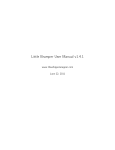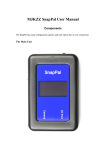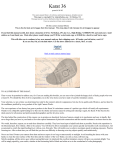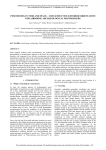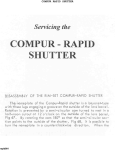Download LITTLE BRAMPER
Transcript
LITTLE BRAMPER - OVERVIEW Collision detection X-time Bulb ramp:↑increasing ↓decreasing Bulb = remaining / total Interval ramp:↑increasing ↓decreasing Interval = remaining / total Frames - ↑count up endlessly or ↓count down to zero. Length of movie clip (secs @ 30fps) B-step (in stops) GLOSSARY (times in milliseconds, 1s=1000ms) INTERVAL - time between start of one shot and start of next. BULB - the exposure time (provided camera is in bulb mode). FRAMES - how many shots to take (0=infinity). BUFFER - time required to write image to card and display image/histogram. X-TIME - cameraʼs minimum bulb exposure (model specific) B-STEP - bulb will jump by this amount (in stops), for use with ISO-stepping and neutral-density filters etc. SAVE - you can save current settings as preset A, B or C. [3] increase interval ramping [6] decrease interval ramping MENU SYSTEM To enter menu system, press one of the keys that doesnʼt have a special function (e.g. [1], [2], [4], [5] ... see keypad diagram). PRESETS THE KEYPAD [A] increase bulb-ramping [B] decrease bulb-ramping You can save your current settings as a preset by choosing option 7:Save in the menu. You can have three presets A, B and C. Preset A is automatically loaded upon power-up/reset. HOLD [B] or [C] during power-up/ reset to retrieve preset. [C] increase bulb by bulb-step [D] decrease bulb by bulb-step [*] EXIT or PAUSE [#] ENTER HOLD [D] during power-up/reset to retrieve most recent parameters (emergency restart). Presets save BULB, INTERVAL, BUFFER, X-TIME, B-STEP, BULBRAMP, INTERVAL-RAMP THE ANATOMY OF A SHOT-CYCLE A shot-cycle starts with firing the camera. Little Bramper waits for the shutter to open (stage 1) this delay is the `shutter lagʼ and is of little interest. Once the shutter curtains have opened, Little Bramper starts timing the Bulb exposure (stage 2). When the exposure is complete, Little Bramper releases the camera, which then writes the image to the CF card and displays it on its LCD - this occurs within the Buffer time (stage 3). Finally we wait until the interval has elapsed (stage 4) and we start the cycle over again. Note that INTERVAL > BULB + BUFFER (+ Shutter lag) CONNECTING LITTLE BRAMPER TO YOUR CAMERA 1. Connect jack on Little Bramper labeled ʻBULBʼ to the remote socket of your camera. 2. Little Bramper monitors shutter activity via the cameraʼs PC (Prontor/Compur) socket. Most mid- to high-end bodies have one (labeled with a flash symbol). If your camera lacks a PC socket (e.g. entry-level bodies like Canon 300D, 350D ...) you can get a Hotshoe-PC adapter. Shown is the Nikon AS-15 Sync Terminal Adapter on the hotshoe of a Canon 350D. 3.5mm mono OR 3.5mm stereo Those buttons ... RESET - Press this to reset device and load preset A. If you hold [B], [C] or [D] it will load that preset instead. Emulate Shutter - mostly for testing purposes. If Bramper freezes or you want to test Bramper without a camera, youʼll need to emulate shutter activity by pressing this button. RESET Emulate Shutter Basic Bramping (day-to-night) 1. Ensure camera is set to `First-curtain syncʼ - usually the default or an option in the cameraʼs menu system. 2. Set BULB to a small value, e.g. B=150ms. Use aperture/ filters to get desired exposure. 3. Set BUFFER. Must be long enough for camera to write image to card and display review image. 1000ms or longer is typical. Fast CF cards may reduce this value. 4. Set INTERVAL. Little Bramper will ensure that INTERVAL > BULB+BUFFER. 5. Press [*] to start time-lapse. Red LED will start blinking. (Press [*] again will pause.) 6. When camera is exposing image, green LED will be lit. 7. Study review image and histograms on cameraʼs LCD screen. If image starts getting too dark, increase the bulb-ramping (by pressing [A]). If image starts getting too bright, decrease the bulb-ramping (by pressing [B]). The bulb-ramping strength is expressed in `stops per 100 shotsʼ. For example, ↑1.4 means that after 100 shots the BULB time will have increased by 1.4 stops, and ↓2.7 means that the BULB time will decrease by 2.7 stops over 100 shots. Collisions As Bulb increases it may eventually encroach upon the Interval duration - this is referred to as a collision. Little Bramper can predict when this is going to happen and will display an asterisk (*) when a collision is going to occur within the next 100 shots. Little Bramper will automatically increase Interval to accommodate the ever increasing Bulb exposures. This is not always a graceful solution. You can avoid this problem by either exploiting the concept of ʻphotographic reciprocityʼ by using ISO-stepping, or manually invoke Interval-ramping. Bramping + ISO-stepping (reciprocity) If you increase the ISO by one stop (e.g. 200 to 400) and decrease Bulb by one stop, the exposure will be the same. This is reciprocity. It is useful when Bulb is getting too large and a collision with Interval is imminent: you can reduce Bulb whilst maintaining your current exposure. X-times for Canon models: 5DII = 33ms 7D = 42ms 40D = 47ms 350D = 45ms 300D =82ms 1. Ensure X-time is correctly set for your model of camera. 2. Prepare yourself for action - youʼll need to get this done within one shot-cycle. 3. While camera is exposing a shot press [D] on Little Bramper to decrease Bulb by amount B-step (in stops). 4. As soon as camera has finished taking image, quickly increase the cameraʼs ISO setting by an amount equal to B-step. Bear in mind cameras only allow you to change ISO in multiples of 1/3 or 1/2 stops, so set B-step accordingly. 5. Repeat the above as needed, until you run out of ISO settings. This also works with Neutral-density filters. If you use a 3-stop filter, set B-step to 3.0. Interval ramping If you start with Intervals of, say, 6s (to capture a nice sunset) but know youʼll need to end with longer intervals (e.g. 20s, to accommodate long exposures) then youʼll need to ramp the Interval. Press [3] to increase Interval-ramping, [6] to decrease it. Like bulbramping, itʼs measured in stops (factors of two). For example, ↑1.0 means that the Interval will have doubled after 100 shots. If youʼre mathematically minded you can compute the implications of interval ramping quite thoroughly (see user manual). As you change the interval the passage of time in the final time-lapse clip will accelerate/ decelerate. This time-warp effect may be desirable in itself. Little Bramper as a regular intervalometer Even if you donʼt want to bramp, Little Bramper can be used like a normal intervalometer, but with the added benefit of arbitrary (sub-second) intervals and interval-ramping. Terminator 1. Put the camera into any mode you like (e.g. Av, Tv, M). 2. Insert the terminator plug (basically just a short circuit) into Little Bramperʼs PC/Hotshoe jack. 3. Bulb is no longer relevant, so set Bulb and Buffer to small values (e.g. 10ms and 1ms) - this gives you access to very short sub-second intervals (c.f. ʻAnatomy of a shot diagramʼ). 4. If you often shoot short-interval time-lapse, consider setting this as a preset. Troubleshooting Little Bramper is a 5volt system. It was designed to be used with 4 NiMH AA cells (4x1.2v = 4.8v). DO NOT USE 1.5v ALKALINE CELLS. If LCD is black or blank upon start-up, try fiddling with the LCD contrast knob. If Little Bramper still misbehaves, check nothing is causing a short-circuit on bottom of circuit board e.g. metal surface, moisture etc. hint: Little Bramper fits Pelican 1020 and 1040 cases. If camera fires but exposure doesnʼt end, check your PC (Prontor/Compur) connection. Shooting very short intervals and the camera stops and/or Little Bramper shows ridiculous numbers? It means youʼre driving your camera beyond its capabilities. Stop doing that. If you want 0.6s intervals then use a speedy camera and fast CF cards. After each shot, Little Bramper computes the next shot and saves these parameter values as preset D. If something catastrophic happens (e.g. batteries die, cable is disconnected, or you accidentally change parameter values), do the following; 1. Pause Little Bramper (press [*]) 2. Address any hardware problems. 3. Restart Little Bramper whilst holding down [D]. This retrieves the parameters of the last photograph taken, enabling you to possibly rescue the time-lapse.









